Qualcomm Snapdragon 805 Performance Preview
by Anand Lal Shimpi on May 21, 2014 8:00 PM EST- Posted in
- Tablets
- Snapdragon
- Qualcomm
- Mobile
- SoCs
- Snapdragon 805
GPU Performance
3DMark
Although it's our first GPU test, 3DMark doesn't do much to show Adreno 420 in a good light. 3DMark isn't the most GPU intensive test we have, but here we see marginal increases over Snapdragon 800/Adreno 330. I would be interested in seeing if there are any improvements on the power consumption front since performance doesn't really change.
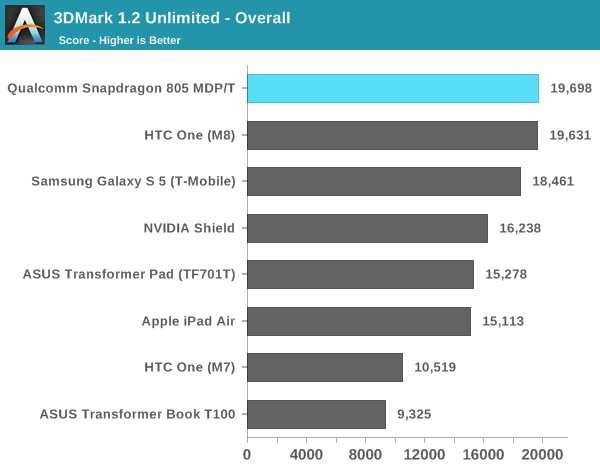


Basemark X 1.1
Basemark X 1.1 starts to show a difference between Adreno 420 and 330. At medium quality settings we see a 25% increase in performance over the Snapdragon 801 based Adreno 330 devices. Move to higher quality settings and the performance advantage increases to over 50%. Here even NVIDIA's Shield with Tegra 4 cooled by a fan can't outperform the Adreno 420 GPU.
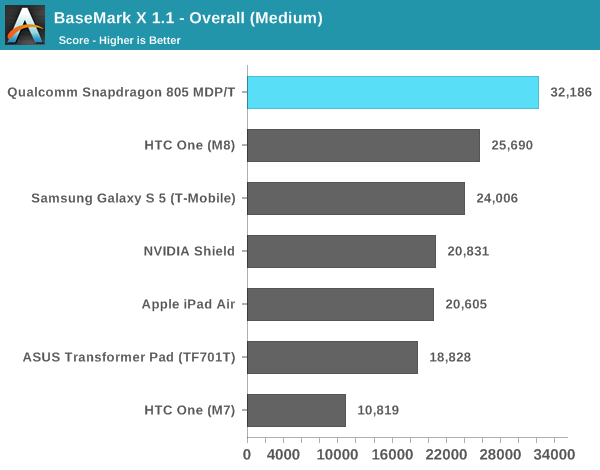
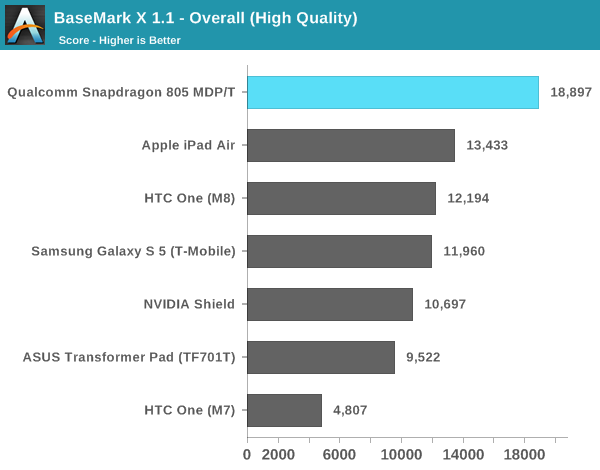
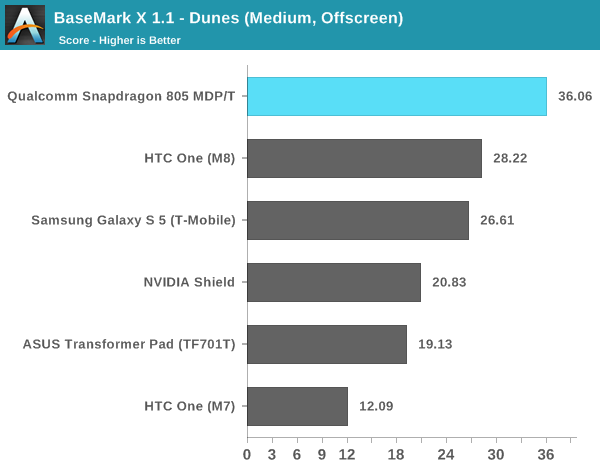
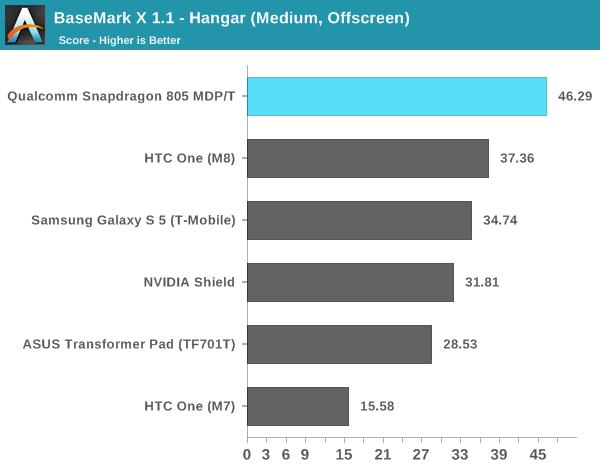


GFXBench 3.0
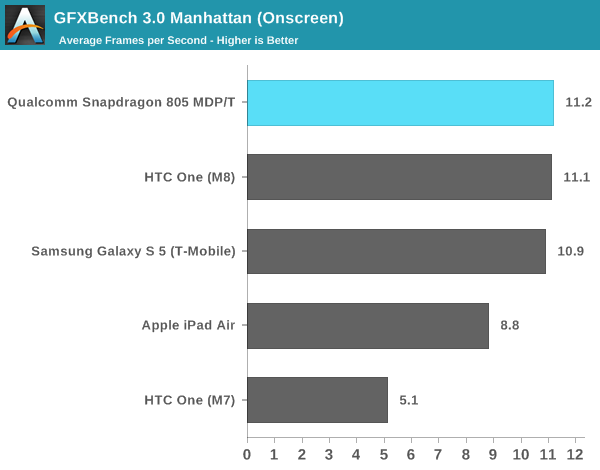
Manhattan continues to be a very stressful test but the onscreen results are pretty interesting. Adreno 420 can drive a 2560 x 1440 display at the same frame rate that Adreno 330 could drive a 1080p display.
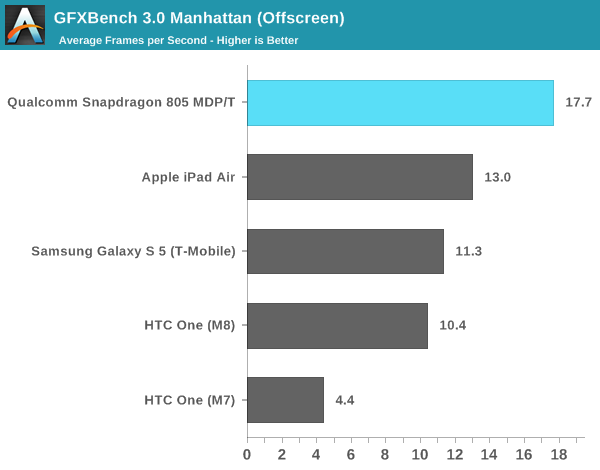
In an apples to apples comparison at the same resolution, Adreno 430 is over 50% faster than Adreno 330. It's also faster than the PowerVR G6430 in the iPad Air.
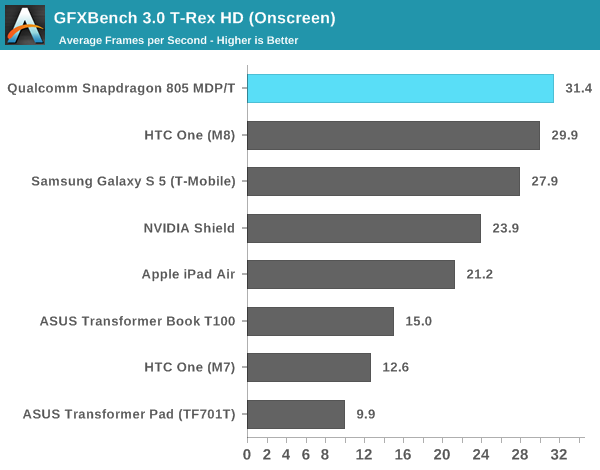
Once again we see an example where Adreno 420 is able to drive the MDP/T's panel at 2560 x 1440 at the same performance as Adreno 330 can deliver at 1080p
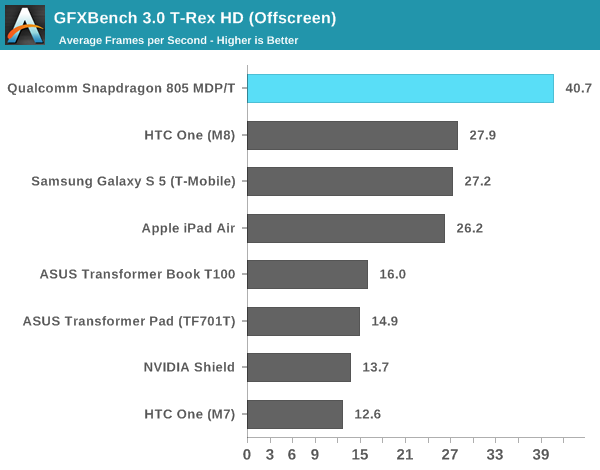
At 1080p, the Adreno 420/S805 advantage grows to 45%.
I've included all of the low level GFXBench tests below if you're interested in digging any deeper. It's interesting that we don't see a big increase in the ALU test but far larger increases in the alpha blending and fill rate tests.
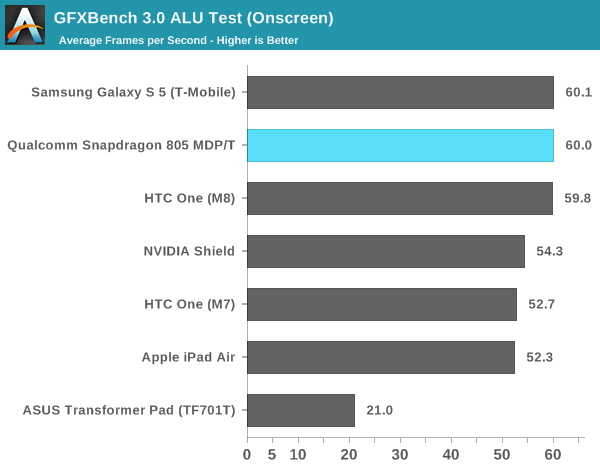
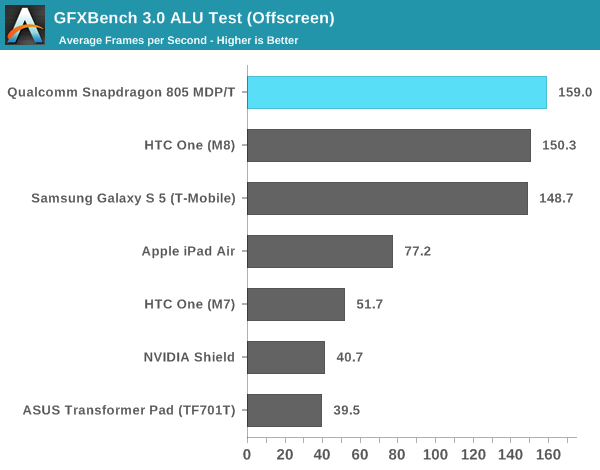
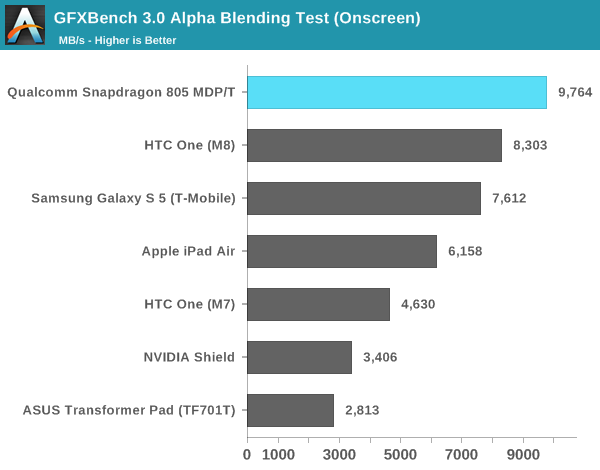

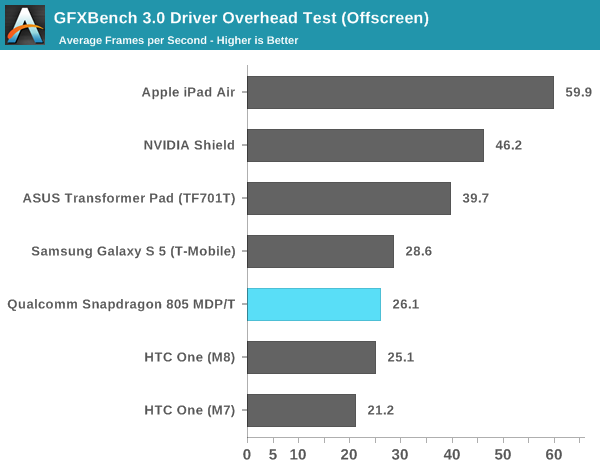
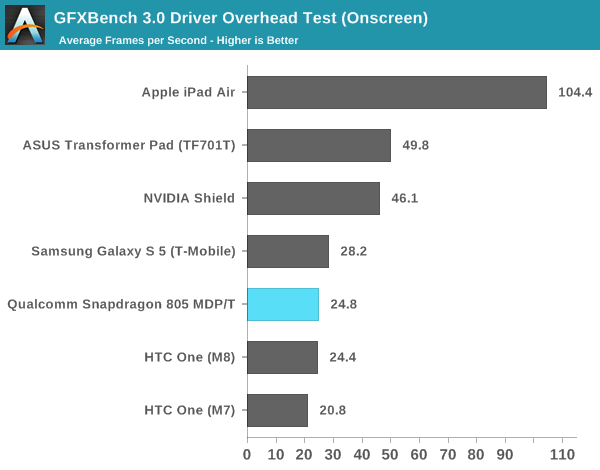
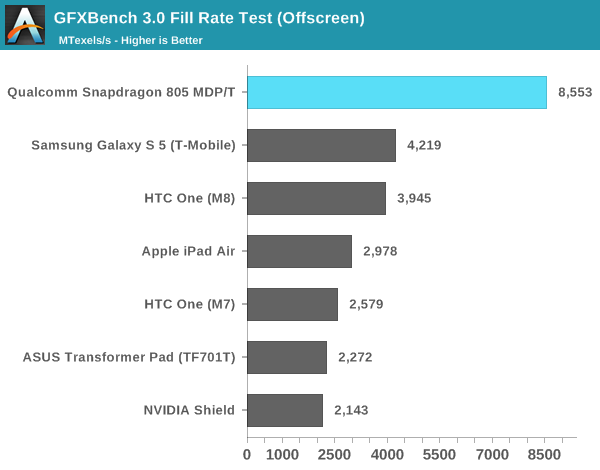
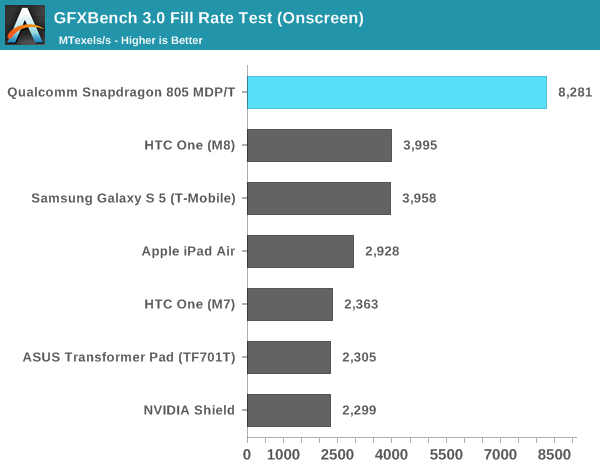










149 Comments
View All Comments
ArthurG - Wednesday, May 21, 2014 - link
ok so this is the year when Qualcomm lost their leadership as 2014 fastest Android SoC appears to be Tegra K1. Much faster GPU (26fps in Manhattan offscreen, 60fps in T-rex offscreen) and faster CPU too (see Xiaomi MiPad benchs).20nm Erista with Maxwell coming same time as S810, Nvidia will even make the gap wider on next generation...
testbug00 - Wednesday, May 21, 2014 - link
Does it matter if Nvidia cannot do it without a fan and higher power usage?The SHIELD is a perfect example of why Nvidia fails to win against Qualcomm in meaningful terms: In the Phone/Tablet market, performance does not matter. Pref/power, and, absolute power do matter.
Until Nvidia learns to make things in lower power envelopes (the T4i is a decent example) they will lose to Qualcomm in meaningful ways.
On that note, The "amazing" K1 chip will be clocked in the 600Mhz range in the first Tablets it comes in... How downclocked will Qualcomm's part be?
Anyhow, if you need absolute performance in the SoC space (aka you are using it as a desktop, or, perhaps a laptop) NVidia is the player to go to. Otherwise, Qualcomm is plain better for phones/tablets.
grahaman27 - Wednesday, May 21, 2014 - link
thats not true, take the tegra note for example. the K1 uses an updated A15 that is more power efficient. then when the custom denver chip hits, it will start taking names and cashing checks.testbug00 - Thursday, May 22, 2014 - link
When Nvidia gets a product with the lines in them, and power tests are done, I will believe it.Until than, Tegra 2, 3, and 4 all cast doubt on that.
__could it happen__ YES!
__Will it happen__ I DOUBT IT :/ :(
fivefeet8 - Thursday, May 22, 2014 - link
You do realize that people have already done power tests with the TK1 boards right? Or are you pretty much ignoring anything until you get your "product with lines in them" argument. If that's the case, then I'm pretty sure the Snapdragon 805 fits in the same boat.testbug00 - Thursday, May 22, 2014 - link
Qualcomm has a history of products being used by OEMs... NVidia has Tegra 2... tons of large OEM design wins... Tegra 3, many large OEM design wins, but, far less... Tegra 4... no large OEM design wins, until they finally got a win in China.Nvidia did not lose design wins magically. Tegra consumed more power than they claimed, and, may have been slower than their claimed.
fivefeet8 - Thursday, May 22, 2014 - link
Why are you arguing about design wins when I'm talking about your power test argument? Have you not seen the power information from users with a TK1 board or not? Or are simply ignoring their findings?testbug00 - Thursday, May 22, 2014 - link
Nvidia lost design wins because they lied about their power usage and performance to OEMs repeatably.Nvidia had plenty of support with Tegra 2, the OEMs though the clockspeeds and power usage looked great... the final product, well, noticeably slower at around the original power promised. So, OEMs grow wary of the next Tegra, but, NVidia might have made an honest mistake... They get number for Tegra 3... Looks great... Get real Tegra 3... substantially slower, more power (at that slower speed) than told.
Nvidia tries to Tell OEMs about their great new Tegra product... and OEMs do not use it, well, major mobile OEMs do not. MS, HP, a few other companies, and, later a large Chinese company.
I have no faith in Nvidia as far as Tegra is concerned. Companies that got Tegra 2, 3 (and perhaps Tegra 4 chips) got real chips. They ran at the clockspeeds NVidia promised, at the power Nvidia promised.
Cherrypicking chips is not hard. It was done to large OEMs, in large enough numbers to let them design many design wins.
I'm not sure why you think it cannot be done for developer boards.
Tegra K1 does look like a good Tegra product finally coming around though. I do not think it will be as good as Nvidia says, based off of the past, but, I don't think it will be as run-of-the-mill as the rest of the Tegra chips were.
ams23 - Thursday, May 22, 2014 - link
Tegra 4/4i was used by various large OEM's including: Asus, HP, Toshiba, Xiaomi, LG, Huawei, ZTE. Of course, that is just smoke, because it has nothing to do with Tegra K1 performance nor power efficiency.testbug00 - Thursday, May 22, 2014 - link
Here is Nvidia's website showing Tegra devices: http://www.nvidia.com/object/tegra-phones-tablets....How many TEGRA 4 (Tegra 4i is a different product, it is a fine product) phones are there? One. By an OEM that also used Qualcomm for the same Phone... I am sure the battery life tests are are the Qualcomm device (happy to be proven wrong)
Otherwise, you have a bunch of PC manufacturers (not large mobile OEMs...) with Tablets/laptops/AIOs. Oh, and, 2 of the 11 products are made by NVidia themselves.
Tegra 4i on the other hand, well, it is what Tegra 3 should have been than some. It is a fine product.